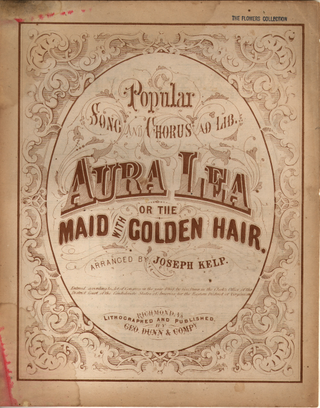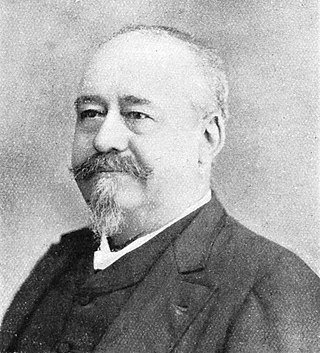"Ar Hyd y Nos" is a Welsh song sung to a tune that was first recorded in Edward Jones' Musical and Poetical Relics of the Welsh Bards (1784). The most commonly sung Welsh lyrics were written by John Ceiriog Hughes (1832-1887), and have been translated into several languages, including English and Breton. One of the earliest English versions, to different Welsh lyrics by one John Jones, was by Thomas Oliphant in 1862.

"Aura Lea" is an American Civil War song about a maiden. It was written by W. W. Fosdick (lyrics) and George R. Poulton (music). The melody was used in Elvis Presley's 1956 hit song "Love Me Tender".
Cwm Rhondda is a popular hymn tune written by John Hughes (1873–1932) in 1907. The name is taken from the Welsh name for the Rhondda Valley.

"Jesus Loves Me" is a Christian hymn written by Anna Bartlett Warner (1827–1915). The lyrics first appeared as a poem in the context of an 1860 novel called Say and Seal, written by her older sister Susan Warner (1819–1885), in which the words were spoken as a comforting poem to a dying child. The tune was added in 1862 by William Batchelder Bradbury (1816–1868). Along with his tune, Bradbury added his own chorus "Yes, Jesus loves me, Yes, Jesus Loves me..." After publication as a song it became one of the most popular Christian hymns in churches around the world, especially among children.

"Just as I Am" is a well-known hymn, written by Charlotte Elliott in 1835, first appearing in the Christian Remembrancer, of which Elliott became the editor in 1836. The final verse is taken from Elliott's Hours of Sorrow Cheered and Comforted (1836).
"Calon Lân" is a Welsh hymn, the words of which were written in the 1890s by Daniel James (Gwyrosydd) and sung to a tune by John Hughes. The song was originally written as a hymn, but has become firmly established as a rugby anthem, associated with the Welsh rugby union, being sung before almost every Test match involving the Welsh national team – though more likely to be heard sung at matches involving the Welsh football team in recent years. In 2007 the song was one of the traditional Welsh songs to make it to the screen in an S4C television series Codi Canu, an attempt to bring traditional four-part harmony choral singing back to the Welsh rugby terraces.
"Angel Band" is an American gospel music song. The lyrics – a poem written in common metre – were originally titled "My Latest Sun Is Sinking Fast," and were written by Jefferson Hascall. The lyric was first set in J. W. Dadmun's tunebook The Melodeon in 1860, to a tune by Dadmun. These words, being in common metre, could be sung to many hymn tunes, but the tune now universally associated them is by William Batchelder Bradbury, and was published in Bradbury's Golden Shower of S.S. Melodies in 1862. Bradbury's song was originally titled "The Land of Beulah." "Angel Band" became widely known in the 19th century, both in folk traditions and in published form, e.g. William Walker's Christian Harmony of 1866, and has been recorded by many artists, probably most famously by the Stanley Brothers, Emmylou Harris, and by the Monkees. The Stanley Brothers version is included on the O Brother, Where Art Thou? soundtrack album (2000).
"Go Tell It on the Mountain" is an African-American spiritual song which was likely derived from the oral tradition, but was originally published by John Wesley Work Jr., although there is some debate over whether he was actually the first to write it. This spiritual has been sung and recorded by many gospel and secular performers since considered a Christmas carol as its original lyrics celebrate the Nativity of Jesus:
Go tell it on the mountain, over the hills and everywhere;
go tell it on the mountain, that Jesus Christ is born.

"Onward, Christian Soldiers" is a 19th-century English hymn. The words were written by Sabine Baring-Gould in 1865, and the music was composed by Arthur Sullivan in 1871. Sullivan named the tune "St Gertrude," after the wife of his friend Ernest Clay Ker Seymer, at whose country home he composed the tune. The Salvation Army adopted the hymn as its favoured processional. The piece became Sullivan's most popular hymn. The hymn's theme is taken from references in the New Testament to the Christian being a soldier for Christ, for example II Timothy 2:3 (KJV): "Thou therefore endure hardness, as a good soldier of Jesus Christ."

"Come Thou Fount of Every Blessing" is a Christian hymn written by the pastor and hymnodist Robert Robinson, who penned the words in the year 1758 at the age of 22.

"Thaxted" is a hymn tune by the English composer Gustav Holst, based on the stately theme from the middle section of the Jupiter movement of his orchestral suite The Planets and named after Thaxted, the English village where he lived much of his life. He adapted the theme in 1921 to fit the patriotic poem "I Vow to Thee, My Country" by Cecil Spring Rice but that was as a unison song with orchestra. It did not appear as a hymn-tune called "Thaxted" until his friend Ralph Vaughan Williams included it in Songs of Praise in 1926.
The Ash Grove is a traditional Welsh folk song whose melody has been set to numerous sets of lyrics. The best-known English lyrics were written by Thomas Oliphant in the 19th century.

"'Tis So Sweet to Trust in Jesus" is a Christian hymn with music by William J. Kirkpatrick and lyrics by Louisa M. R. Stead. The lyrics were written in 1882. They appeared in Stead's Songs of Triumph.

"Come, Thou Long Expected Jesus" is a 1744 Advent and Christmas carol common in Protestant hymnals. The text was written by Charles Wesley. It is performed to one of several tunes, including "Stuttgart", "Hyfrydol", and "Cross of Jesus". The hymn is considered an enduring classic in Christian hymnody.

John Robson Sweney was an American composer from Pennsylvania. He was a professor of music at the Pennsylvania Military Academy for twenty-five years and collaborated with William J. Kirkpatrick to produce and publish over 1,000 gospel hymn songs and over sixty hymnal books. His most popular and widely known hymn is "Beulah Land".

Charles Austin Miles was a prolific American writer of gospel songs, who is best known for his 1912 hymn "In the Garden".

"O'er the Gloomy Hills of Darkness", also titled "O'er Those Gloomy Hills of Darkness", is a Welsh Christian hymn by William Williams Pantycelyn written in 1772. The hymn was written as a missionary hymn; there are conflicting accounts of why the hymn was written. The hymn was later published in 374 hymnals worldwide, though it was censored and altered in the United States by slaveholders for evangelising to slaves. The hymn later fell out of favour with hymn book editors in the 1960s.
"Ermuntre dich, mein schwacher Geist" is a German Christmas carol with lyrics by Johann Rist and a melody by Johann Schop, first published in 1641. Historically it was contained in Protestant hymnals, but the current one, Evangelisches Gesangbuch, uses only three of its stanzas, the ninth, the second and the twelfth, titled "Brich an, du schönes Morgenlicht". This stanza was used by Johann Sebastian Bach as a chorale in Part II of his 1734 Christmas Oratorio.
"Let us break bread together" is a traditional Christian hymn. Its melody is searching, simple, major key, and has simple lyrics.











